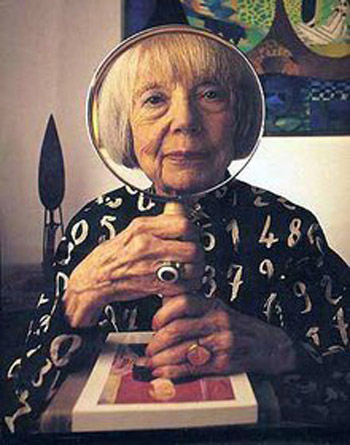|
EILEEN
AGAR : ANGEL OF ANARCHY
Leeds Art Gallery, 29th January, 2022 to 7th
May, 2022
Reviewed by Jim Burns
The role of women in the Surrealist movement has often been
underplayed, at least until relatively recently. And thereís no
getting past the fact that there was a great deal of misogyny among
the Surrealists. Women
were wives, mistresses, sex objects, but rarely given credit as
creators of Surrealist art. And yet major exhibitions, such as
Angels of Anarchy: Women
Artists and Surrealism at Manchester Art Gallery in late-2009
and early-2010, and Women
Artists and Surrealism at the Picasso Museum, MŠlaga, in 2017,
have demonstrated how much imaginative work was produced by women
functioning within a framework of Surrealism.
Eileen Agar was represented in the exhibitions Iíve referred to, and
the earlier neglect of her work might be explained not only by the
fact of her female status, but also perhaps because she was usually
identified as a British Surrealist. And for a long time British
Surrealism was looked on by critics as mostly being a weak imitation
of the real thing that came from the Continent. The British artists
were said to be too whimsical and less convincing and unlikely to
portray a deeper, darker and more disturbing aspect of Surrealism.
An exhibition, British
Surrealism in Context: A Collectorís Eye, at the Abbott Hall
Gallery, Kendal, in 2014 certainly demonstrated that whimsy could
play a part in some British Surrealist paintings, but it wasnít the
whole story.
Eileen Agar was born in Buenos Aires in 1899 to a Scottish
businessman father and an American mother. From an early age she was
sent to private schools in England, and was encouraged by
sympathetic teachers to develop an interest in art. Later, she
studied for a time at the Slade, though she expressed
dissatisfaction at the teaching and general atmosphere there. By the
early-1920s she had experienced a brief, unsuccessful marriage,
toured in France and Spain, and met the Hungarian writer Joseph Bard
with whom she had a fifty-year relationship. This didnít prevent her
from having an intense affair with Paul Nash, and another with the
French poet, Paul …luard. Iím compressing details of Agarís life,
and she studied Cubism in Paris and mixed in circles which included
Picasso, Ezra Pound, Brancusi, Andrť Breton, and other talented
poets and painters.
She also encountered people in what might be called the British
avant-garde when Herbert Read and Roland Penrose visited her studio
and selected some of her work for the nowĖfamous New Burlington
Gallery, International
Surrealist Exhibition in London in 1936.
Agar used to say that she
hadnít known she was a Surrealist until Read and Penrose told her
she was. And it seems she didnít like the label. Artists and writers
often do deny a group identification, preferring to have their work
judged on its own merits rather than those of a supposed movement.
Itís usually critics and art historians who want to place people in
neat and tidy categories.
But things are much more complicated than that and
individuals donít observe boundaries and take what they want from
various sources.
Was she a Surrealist? Walking around the Leeds exhibition itís easy
to see that elements of what is usually referred to as Surrealism
can be located in the paintings, photographs, and other items on
display. But she was interested in ďfound objectsĒ and took pictures
of rock formations shaped by accidents of nature, and trees broken
and gnarled by the effects of extreme weather conditions. It was the
physical appearance of these objects that seemed to intrigue her
rather than any deep meaning that may have been attached to them.
Her paintings incorporated elements of Cubism and Surrealism,
without falling into any kind of slavish imitation or pattern of
prescribed Cubist or Surrealist intentions. And, yes, the whimsical
is there and why not? Itís noted that Agar had a liking for Lewis
Carroll, and I recall the American poet Robert Bly (I think It was)
expressing his objection to a British assertion that we
didnít really need Surrealism because we have, among other things
such as Edward Lear and a long tradition of Gothic novels and ghost
stories, the Lewis Carrol books.
There may be a case for the whimsical and the idea that the
gloomy is not necessarily profound, nor the cheerful shallow.
Itís a pleasure to see an exhibition that features a wide range of
work produced across a lifetime (she died in 1991) of activity. And
to have it backed up by a selection of documents Ė among them
exhibition catalogues and old magazines such as the four issues of
Island, a publication
part-edited by Joseph Bard and to which Agar contributed. A true
little magazine it lasted only a short time, but played its part in
the artistic ferment of the period. The role of magazines like it
should never be under-estimated because they seem slim and fragile
and few people saw them at the moment of their appearance. The
audience they reached was an informed and important one.
Back to the question Ė was Aileen Agar a Surrealist? Sheís in the
books and the exhibitions, and thatís useful in terms of drawing
attention to what she did. But it doesnít really matter. The work,
with its vibrant use of colour and subtle suggestions of humour, has
its own values and is worth looking at on those grounds.
|
